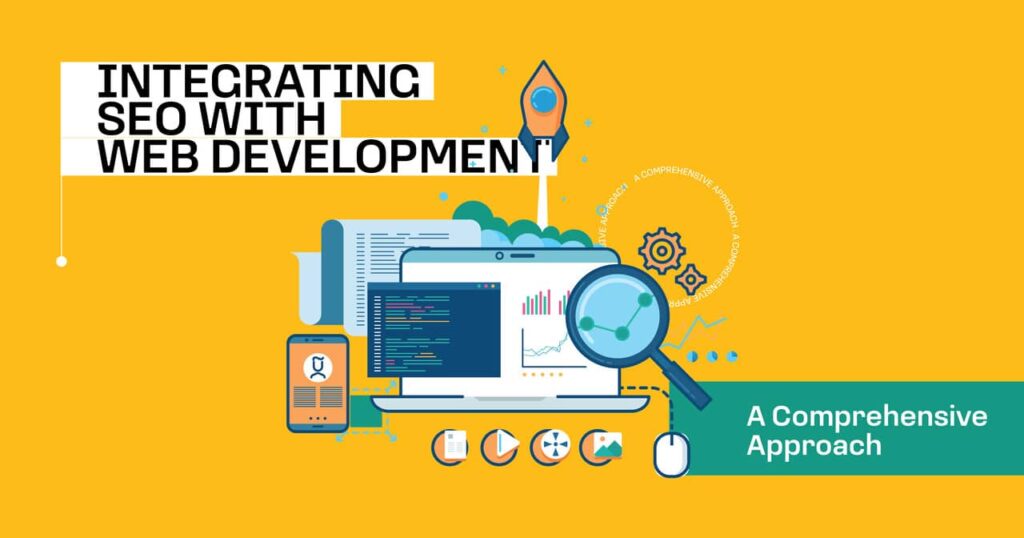In today’s digital landscape, integrating SEO with web development isn’t just a strategy—it’s a necessity. The intersection of these two disciplines ensures that your website isn’t just functional and attractive but also optimized for search engines, which is crucial for attracting and retaining visitors.
Essential Takeaways
- Content and Technical SEO: Quality content boosts SEO, while technical SEO ensures search engines can crawl your site effectively. Combining both improves rankings and user experience.
- Design vs. Functionality: A great design shouldn’t hurt performance or SEO. Aim for a user-friendly design that also follows SEO best practices, like optimized images and clean code.
- Continuous Improvement: SEO and web development are ongoing. Regularly monitor, audit, and update your site to keep up with trends and maintain high search rankings.
In this comprehensive guide, we’ll explore how to effectively blend SEO with web development to boost your site’s performance, enhance user experience, and improve your search engine rankings.
Introduction to SEO and Web Development
What is SEO and Why It Matters
Search Engine Optimization (SEO) is the practice of enhancing your website to improve its visibility on search engines like Google. The ultimate goal of SEO is to increase your website’s organic (non-paid) traffic by ranking higher on search engine results pages (SERPs). SEO encompasses various techniques, including on-page optimization (like content and meta tags), off-page optimization (such as backlinks), and technical SEO (site structure and performance).

Why does SEO matter? Simply put, higher visibility on search engines translates to more traffic. When users search for relevant keywords, you want your website to appear among the top results. This increased visibility not only drives more visitors to your site but also builds credibility and trust with your audience.
What is Web Development and Its Role
Web development is the process of creating and maintaining websites. It involves both front-end (what users see and interact with) and back-end (server-side functionality) development. Front-end development includes designing the layout, user interface, and user experience, while back-end development focuses on server management, databases, and application logic.
The role of web development in creating a successful website cannot be overstated. A well-developed website ensures that users have a positive experience, which can lead to increased engagement, higher conversion rates, and improved SEO performance. For instance, a site that loads quickly and is easy to navigate is more likely to retain visitors and rank higher in search results.
The Intersection of SEO and Web Development
Why Integrate SEO with Web Development?
Integrating SEO with web development ensures that your website isn’t just built to look good but also to perform well in search engine rankings. When SEO considerations are integrated from the beginning of the web development process, it prevents issues that can arise from neglecting SEO during design and development.

For example, a website with poor site structure or slow loading times can negatively impact SEO performance. By addressing SEO and web development together, you can avoid such pitfalls and create a site that is both user-friendly and search engine-friendly. This integrated approach leads to better search rankings, increased traffic, and a more satisfying user experience.
Key Areas of Integration
Site Structure and Architecture
A well-organized site structure is crucial for both users and search engines. It helps users navigate your site easily and allows search engines to crawl and index your pages efficiently. Key elements to consider include:
- URL Structure: Use clean, descriptive URLs that include relevant keywords. For example, instead of www.example.com/page1, use www.example.com/seo-tips.
- Internal Linking: Create a logical internal linking structure to guide users and search engines to related content. This helps distribute page authority and improves the overall user experience.
- Navigation: Ensure that your site’s navigation is intuitive and easy to use. A clear menu and well-structured categories make it easier for both users and search engines to find important content.
Responsive Design
With the increasing use of mobile devices, responsive design has become a critical aspect of web development. Responsive design ensures that your website adapts to different screen sizes and devices, providing a seamless experience for all users. Key considerations include:
- Mobile-Friendliness: Ensure that your site is optimized for mobile devices. Google uses mobile-first indexing, meaning that the mobile version of your site is considered the primary version for ranking purposes.
- Viewport Meta Tag: Use the viewport meta tag to control the layout on mobile browsers. This tag helps ensure that your site displays correctly on different screen sizes.
Page Speed Optimization
Page speed is a crucial factor in both user experience and SEO. A slow-loading website can frustrate users and lead to higher bounce rates. Google also considers page speed as a ranking factor. To improve page speed, focus on:
- Image Optimization: Compress images to reduce file size without sacrificing quality. Use modern formats like WebP for better compression.
- Minification: Minify CSS, JavaScript, and HTML files to reduce their size and improve loading times.
- Caching: Implement browser caching to store static resources and reduce load times for returning visitors.
SEO Considerations During the Development Process
Keyword Research and Implementation
Keyword research is the foundation of effective SEO. By identifying the right keywords, you can optimize your content to match what users are searching for. Here’s how to integrate keyword research into web development:
- Keyword Research: Use tools like Google Keyword Planner, SEMrush, or Ahrefs to find relevant keywords for your industry. Look for keywords with high search volume and low competition.
- Keyword Placement: Incorporate keywords naturally into your content, titles, meta descriptions, and headers. Avoid keyword stuffing, which can harm your SEO performance.
On-Page SEO Elements
On-page SEO involves optimizing individual pages to rank higher and earn more relevant traffic. Key elements to focus on include:
- Title Tags and Meta Descriptions: Craft compelling title tags and meta descriptions that include target keywords. These elements appear in search results and influence click-through rates. For example, instead of “Home Page,” use “SEO Services for Small Businesses | [Your Company Name].”
- Header Tags and Content Optimization: Use header tags (H1, H2, H3) to organize your content and make it easier for users and search engines to understand. Ensure that your content is well-written, informative, and optimized for your target keywords.
Technical SEO Aspects
Technical SEO ensures that your website is accessible and indexable by search engines. Key aspects to consider include:
- XML Sitemaps and Robots.txt: Create and submit an XML sitemap to help search engines discover and index your pages. Use the robots.txt file to control which pages should be crawled and indexed.
- Structured Data and Schema Markup: Implement structured data (schema markup) to help search engines understand the context of your content. This can improve your visibility in search results and enhance your site’s appearance with rich snippets.
Common Challenges and Solutions
Balancing Design and SEO
One of the main challenges in integrating SEO with web development is balancing design and optimization. While a visually appealing design is important, it should not compromise SEO performance. Here are some strategies to address this challenge:
- Prioritize Functionality: Ensure that design elements do not hinder site functionality. For example, avoid using complex animations that can slow down page load times.
- Collaborate with Stakeholders: Work closely with designers, developers, and SEO professionals to align on design and optimization goals. Regular communication and feedback can help achieve a balance between aesthetics and SEO.
Managing Site Changes and SEO Impact
Site updates and redesigns can impact SEO if not managed properly. To minimize SEO disruptions during site changes:
- Implement Redirects: Use 301 redirects to guide users and search engines from old URLs to new ones. This helps preserve your SEO value and avoid broken links.
- Monitor Performance: Track your site’s performance before and after changes using tools like Google Analytics and Search Console. This allows you to identify and address any issues quickly.
Collaboration Between SEO and Development Teams
Effective collaboration between SEO and development teams is crucial for successful integration. To facilitate collaboration:
- Use Project Management Tools: Tools like Trello or Asana can help manage tasks and track progress.
- Schedule Regular Meetings: Hold regular meetings to discuss progress, address issues, and align on goals.
- Share Knowledge: Foster a culture of knowledge sharing between teams. For example, SEO professionals can provide insights on keyword trends, while developers can offer technical expertise.
Best Practices for Ongoing SEO and Web Development
Continuous Monitoring and Optimization
SEO and web development are ongoing processes. Regular monitoring and optimization are essential for maintaining and improving performance. Here’s how to stay on top of things:
- Conduct Regular SEO Audits: Perform periodic audits to identify and fix SEO issues. Tools like Screaming Frog or SEMrush can help with this.
- Analyze Site Metrics: Use analytics tools to monitor key metrics like traffic, bounce rate, and conversion rates. This helps identify areas for improvement.
Staying Updated with SEO Trends
SEO is constantly evolving, and staying informed about the latest trends is crucial for maintaining a competitive edge. To keep up with SEO developments:
- Follow Industry Blogs: Stay updated with industry blogs and news sites like Moz, Search Engine Journal, and Neil Patel.
- Attend Webinars and Conferences: Participate in SEO webinars and conferences to learn about new techniques and network with industry experts.
- Adapt to New Technologies: Keep an eye on emerging technologies like AI and voice search, and adapt your SEO strategies accordingly.
Call to Action
Ready to take your website to the next level? Integrating SEO with your web development process is the key to unlocking higher search rankings and better user experiences. Contact us today to learn how we can help you optimize your website for success. Don’t wait—let’s start building a more effective online presence together!
FAQs
- What is the difference between SEO and web development?SEO (Search Engine Optimization) focuses on improving a website’s visibility on search engines to drive organic traffic. Web development, on the other hand, involves building and maintaining the website itself. Integrating the two ensures that the website is both functional and optimized for search engines.
- Why is technical SEO important for web development?Technical SEO ensures that a website is accessible and indexable by search engines. This includes optimizing site speed, mobile responsiveness, and site structure. Proper technical SEO helps improve search rankings and provides a better user experience.
- How can I ensure my website design doesn’t negatively impact SEO?To avoid negatively impacting SEO, ensure that design elements do not hinder site performance. Focus on optimizing images, minimizing code, and ensuring fast load times. Collaborate with SEO professionals during the design phase to balance aesthetics with functionality.
- What role does responsive design play in SEO?Responsive design ensures that a website adapts to different screen sizes and devices, which is crucial for both user experience and SEO. Google uses mobile-first indexing, meaning the mobile version of your site is considered the primary version for ranking.
- How often should I update my website for SEO purposes?Regular updates are important for maintaining SEO performance. Conduct SEO audits periodically, update content as needed, and stay informed about SEO trends and algorithm changes. Aim to review and optimize your site at least quarterly.









